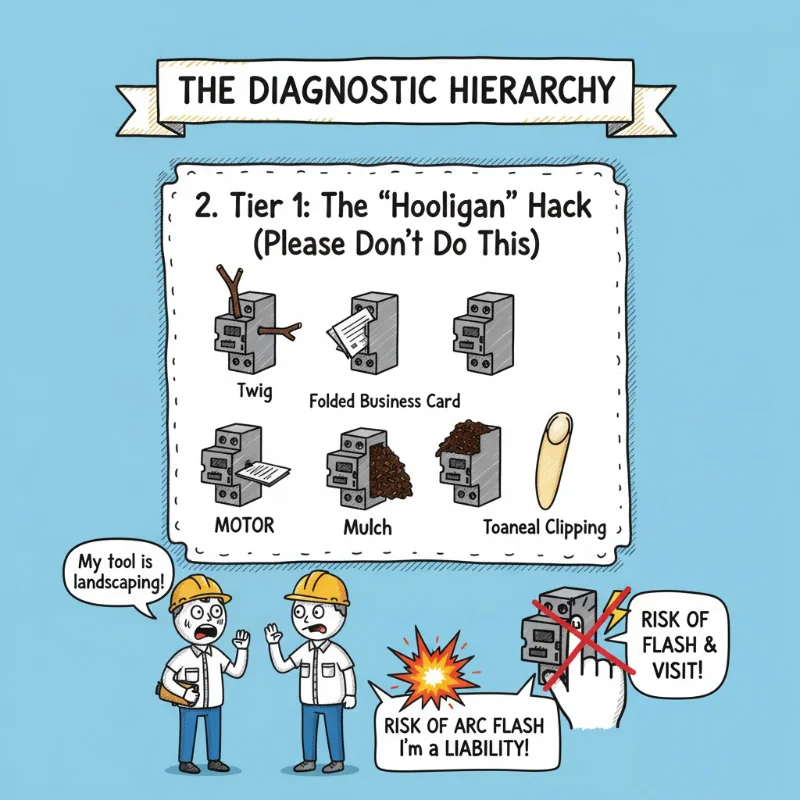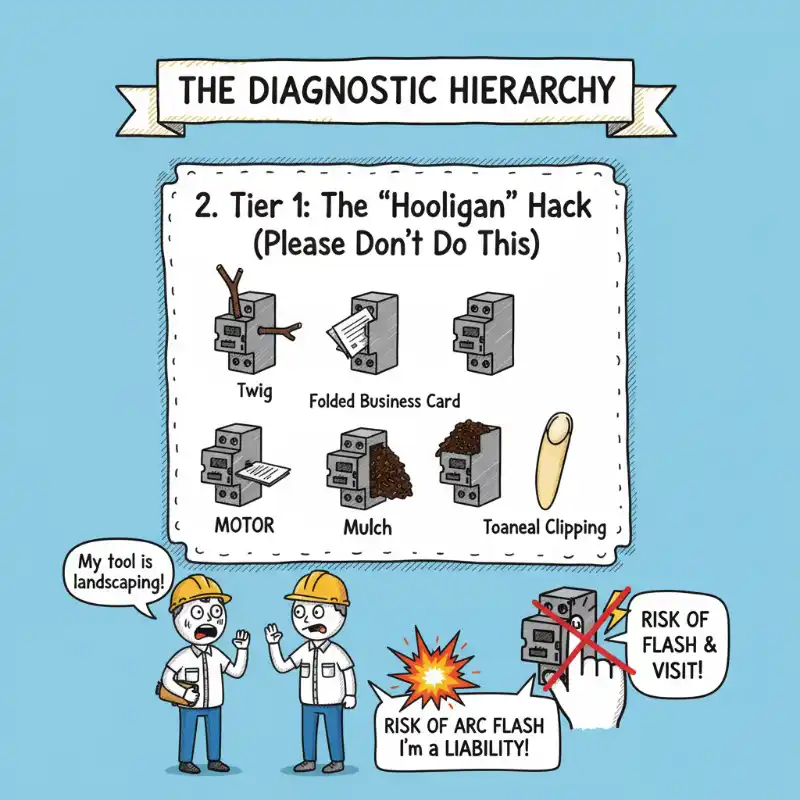You’re on-site. A critical 480V motor-driven pump is down. The PLC isn’t calling for it to run, but you need to force-start it to check a bearing alignment.
You’re standing in front of the high-voltage 접촉기. You need to bypass the PLC and close it, manually.
You can’t use your finger. Not unless you want a shocking story for the ER doctor and a very, very long talk with the safety manager. So, what do you do?
A tech recently asked a popular online forum the “secret handshake” question: “What ‘gadget’ or ‘hack’ do you use to hold the plunger down?”
The flood of answers—ranging from ingenious to insane—revealed a perfect hierarchy of skill. The tool you choose reveals everything about your level of expertise.
Where do you fall on “The Diagnostic Hierarchy”?
Tier 1: The “Hooligan” Hack (Please Don’t Do This)
This first tier is a collection of jokes… that are scarily close to reality. When asked what they use to “wedge” a contactor, the “Hooligan” tier responses flew in fast:
- “Jam a twig or a #10 sheet metal screw in it.”
- “A folded-up business card or a piece of cardboard.”
- “Just pack the housing with mulch until it stops moving.”
- And, my personal favorite: “A large toenail clipping.”
This is “The Mulch Maneuver.” It’s the “Property Maintenance” special. It’s a non-professional, zero-safety, “get it done” hack that shows a complete lack of respect for the 480V you’re dealing with.
프로 팁: If your “tool” is part of the landscaping, your lunch, or your own body… you are a liability, not a technician. Using a non-insulated screwdriver, a car key, or (God forbid) your actual finger is in this tier. This is how you cause an arc flash. This is how you get hurt.
Tier 2: The “Veteran” Hack (The Fast… But Flawed… Method)
This is where the 실시 field techs, “The Physics Gang,” chime in. This tier is all about efficiency.
- The Tool: A dedicated contactor magnet or the perfectly shaped insulated handle of a high-quality Klein screwdriver.
- How it Works: They physically force the plunger down. The magnet snaps onto the plunger and holds it, or the screwdriver handle wedges perfectly between the plunger and the housing.
- The Pro: It’s fast. It’s 1,000% safer than the “Hooligan” tier (assuming you’re using properly insulated tools). It gets the motor spinning, and you can get on with your diagnosis.
It’s a clever, field-tested hack. And for 10 years, you might think it’s the best way.
But it’s not. It’s diagnostically incomplete. You’ve just walked right into “The Diagnostic Blind Spot.”
Tier 3: The “Master” Hack (The Safe & Diagnostically Complete Method)
The “Master” doesn’t force the part; they test the system.
While “The Physics Gang” is arguing about the best brand of magnet, “The Electrical Gang” sighs, pulls out a fused jumper wire, and solves the problem correctly.
- The Tool: A simple, fused 24V (or 120V, depending on your control circuit) jumper wire.
- How it Works: They completely ignore the 480V “muscle” side. They go directly to the low-voltage “brain”—the A1 and A2 coil terminals. They apply the correct control voltage directly, simulating the exact signal from the PLC.
This simple step is what makes them a “Master.” It solves “The Diagnostic Blind Spot.”
Here’s the “Aha!” moment:
- If the contactor pulls in (CLUNK!): You’ve just proven the entire contactor (coil, mechanical linkage, 그리고 contacts) works perfectly. The problem is upstream (the PLC, the control wiring, the interlock).
- If the contactor doesn’t pull in: You’ve found the 실시 fault: a bad coil.
Think about that.
The “Veteran” (Tier 2) would have forced the plunger with his magnet. The motor would run. He would have completely missed the broken coil. He would have blamed the PLC and wasted three hours troubleshooting the wrong thing… only to have the motor fail again the second he removed his magnet.
The “Master” finds the true fault in 30 seconds.
프로 팁: Always use a fused jumper for this. It’s the difference between a pro and a risk-taker. If you accidentally hit ground or short something, you’ll pop a 50-cent fuse. If you use a random piece of wire, you could smoke the $500 control transformer or the entire PLC power supply.
Conclusion: Your Tool Reveals Your Expertise
The “hacks” you use expose your understanding of the entire electrical system.
The Access-A-Ride Hooligan uses a twig. They understand nothing and are a danger to themselves and others.
그리고 Veteran uses a magnet. They are fast and efficient but have a “Diagnostic Blind Spot” that can lead to a misdiagnosis.
그리고 Master uses a fused jumper. They are safe, efficient, and diagnostically complete. They don’t just force a part; they understand why it’s not working.
Be a Master. Understand the whole system.
에서 VIOX, we build components for professionals who know the difference. Our contactors have clearly marked, top-accessible coil terminals (A1/A2) specifically for this kind of professional, “Master-level” diagnostic.
Check out our full line of industrial contactors and relays, built for the “Masters” of the trade.







